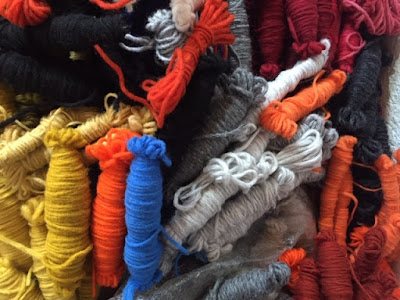Over the past few months, we've joined Jose's parents, Victor and Josefina, a few times to help them with their corn harvest. Well, to be more precise, they mostly pick and we mostly eat. Corn grows year round here and in late October the first ears were ready to harvest again. So, we headed out in the field and got a lesson from
Victor on how to pick only the ripest ears of his yellow corn.

Margarita and I helping with the harvest.
 |
| Then we headed back to their farm with bags full of corn. |
After picking about 75 ears, we shucked and boiled them in a big pot. Now, I'm from corn-country, and I like corn-on-the-cob as much as anyone, but when Ecuadorians boil a pot of "choclo" as they call it, they expect to eat! Little Pablo ate 11 ears! Choclo is smaller and has a little bit different texture than US sweet-corn, but served with salt,
a block of Queso Freso cheese or a spicy ahí sauce, the ears do seem to go down quickly.
After several weeks of harvesting small batches of his corn to eat and gift to family,
Victor announced that the corn still in the field was at a perfect state for making humitas.
So, we headed over to their house again for an Humita Party!
Humitas, or corn cakes, are a favorite staple of the Ecuadorian diet. They are eaten for breakfast sautéed in a little oil, or steamed in the late afternoon/ early evening to nosh with a café. Small little restaurants abound- often assembled in people's front walkway
or garage- ready to serve humitas to anyone passing by.
People swear by specific recipes and their deliciousness!
After a lot of discussion and tasting on the part of Margarita and Faby,
we ended up (more or less) with the following procedure and recipe:
Recipe: Homemade Humitas
Step 1: Pick bags of choclo by hand fresh from the field
Step 2: One person shucks and saves the clean inner-leaves for the wrap
Step 3: Four other people de-kernel by hand for almost two hours
 |
| Margarita, Faby and Jose's sister Veronica help Victor and Josefina with the corn. |
Step 4: Two adults and two children wash and grind the kernels in a traditional molino, or mill.

 |
| Alex and Pablo are helping with the molino. |
 |
| I expected the ground corn kernels to make more of a dry corn meal, but what came out was a very wet mush. |

Step 5: To this mush, add:
24 eggs
1/3 of a small can of baking powder
2 cups melted butter
1 cup sugar
*1 super giant wooden spoonful of salt
*Before adding the salt, you can reserve some of the mush to make sweet humitas. Simply add more sugar and a bag of anis seeds.
Step 6: Stir all ingredients together with your hands.
 |
| Faby is demonstrating how to mix it all together with your hand. |
Step 7: If you don't have a big enough stove, or you are making a lot of humitas, start a fire
in the kitchen for a second pot to steam.
 |
| Wilo is starting the fire. |
Step 8: Gather a lot of volunteers around the pot of mush. Drop two spoonfuls of corn mush into a clean corn husk and wrap up like a packet.
Margarita, Josefina, Faby and Alex are showing me how it's done.
Step 9: After you have many packets made and the fire is ready, layer the husk packets in a giant pot to steam. Use a pot with metal shelves to space out the layers, or use more husks to create layers between the humitas.
Step 10: Cover the pot with a tight fitting lid and steam for 30-35 minutes on a stove or over an open fire.
Step 11: The humitas are finished when the mush has formed a cake inside the husk.
Step 12: Enjoy your humitas with coffee and Queso Freso Cheese.
This recipe makes more than 100 humitas...
which is just right for a family to eat and share!

























































